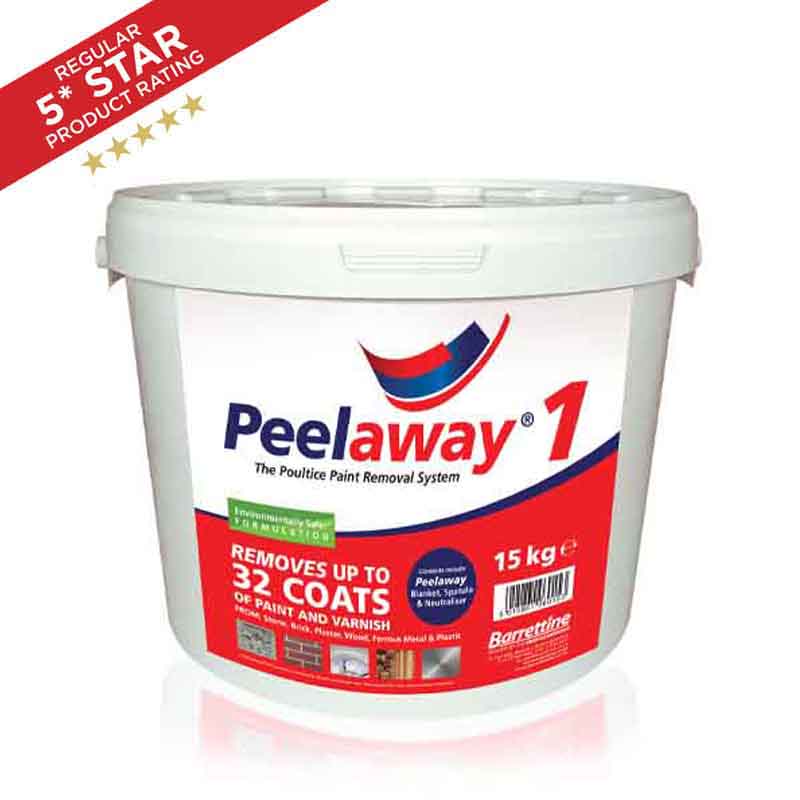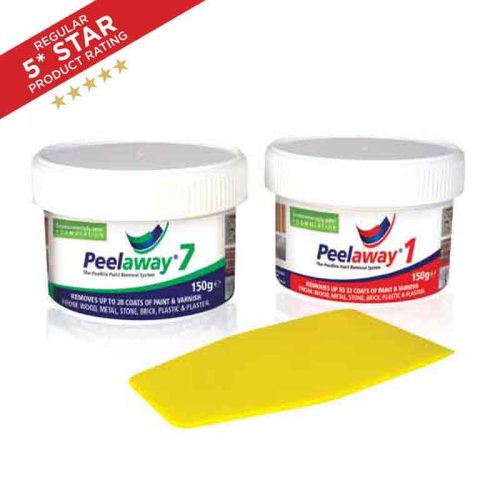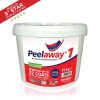FREE SHIPPING AVAILABLE ON ORDERS OVER £75.00*
Barrettine PeelAway 1
We always recommend firstly using the Away 1 & 7 sample pack to find out which paint remover system is suitable for your specific job and how thick you would be required to apply it.
- Suitable to remove paint from wood, brickwork, stone, concrete, marble, decorative plaster, cornices and plaster walls
- Removes up to 32 coats containing oil, lead, Polyurethane or water
- Architecturally Specified
- Methylene Chloride Free
- Requires neutralising with the supplied neutraliser
£55.10 – £122.70
Product Description
Barrettine PeelAway 1 is a water based alkaline paste designed to safely remove multiple layers of most types of paint form surfaces such as walls and brickwork. It mainly removes old lead based paints.
Removes coatings including:
- oil, lead, polyurethane or water from wood, brick, stone, steel, iron, concrete, marble, decorative plaster cornices and plaster walls.
- Will remove painted wall paper.
Peelaway® 1 is suitable for almost all indoor and outdoor surfaces. Perfect for intricate, carved and moulded surfaces. Apply the paste by spatula, brush, trowel or spray* onto the surface. Then, cover with the Peelaway® blanket for the required time (dwell time).
*When spraying, dilute up to 1 part water to 5 parts Peelaway® 1. We recommend an airless sprayer for heavy materials with a medium to coarse tip size.
Pack includes Barrettine Peelaway 1, Blanket, Spatula and Neutraliser. You can also order additional neutraliser or blankets.
Always carry out a test patch first
Please read all the instructions and safety information before starting work.
Preperation
Cover and protect areas where stripping is not desired, including adjoining surfaces where over spray may travel. Polythene sheeting and masking tape create an effective barrier. Plants and other foliage should be covered during application. For interior use, use Polythene sheeting and masking tape to cover and protect adjacent surfaces, including flooring. Do not sand / remove flakes of paint if suspected to contain lead.
SAFETY: Wear coveralls, chemical resistant gloves, face mask and eye protection. Ensure adequate cross ventilation if indoors. Keep product away from children and animals. Store product in a cool dry area and always replace the lid after use. In case of spillage, wash the affected area with plenty of water.
Test Areas
Before using this product always conduct a Test Patch.
It is often impossible to know the type of paint or surface before the coating is removed, therefore it is essential that a test area be completed typical of the surface to be stripped to help insure that the results will be satisfactory.
Twin Test patch kits are available from your local Peelaway® supplier or directly from Barrettine. The Test Patch kit consists of both Peelaway® 1 and Peelaway® 7. Test patches should be completed before undertaking any paint removal project. The test patches should be typical of the surface to be stripped and include irregular as well as flat surfaces. This will confirm you have selected the correct Peelaway® product, thickness of paste and time span for clean removal. It is the responsibility of the purchaser/end user to determine the suitability of the Peelaway® product with the substrate to be stripped. Each project can potentially give different results and this is why it is imperative to carry out Test Patches. Leaving on for insufficient time could mean the process has not completed. Leaving on too long could damage the substrate or you may find the Peelaway® blanket and paste becomes too hard and difficult to clean up. Once a small test patch has confirmed that the Peelaway® product selected has worked we strongly recommend that larger areas are tested before starting your stripping project. This will allow a more accurate estimate of the thickness and time required to complete the stripping process. Barrettine accept no responsibility or liability with regards to any damage or unsatisfactory results caused by the use of Peelaway® products.
Application
Uneven Surfaces: Apply thickly (1mm to 6mm e.g. 1mm when removing varnish only) with brush or spatula working Peelaway® 1 into crevices, mouldings etc. Apply a second coat where appropriate to ensure correct thickness has been achieved as indicated by the test patch. Apply Peelaway® poultice blanket over paste with printed side face out, rubbing gently to ensure good adhesion to the paste, pierce any air bubbles. Dwell time will be as determined by the test patch, between 1 and up to 48 hours depending on paint types, thickness and temperature. Heavy paint build-up over plaster mouldings may need even longer (up to 72 hours), and this can often aid the drying out process which encourages the old paint and blanket to lift away from the substrate being treated to complete the stripping process.
Flat Surfaces: Apply (1mm to 6mm e.g. 1mm when removing varnish only) with a brush, spatula, hawk and trowel or industrial sprayer to required thickness. Apply Peelaway® poultice blanket over paste with printed side face out, rubbing gently to ensure good adhesion to the paste, pierce any air bubbles. Dwell time will be as determined by the test patch, between 1 and up to 48 hours depending on paint types, thickness and temperature.
As a guide coverage is approximately 1m2 per kilo at 1mm thick.
Only apply to an area size that is manageable and that can be stripped within the timescale indicated by the Test Patch.
External use may be affected by extremes of weather conditions and additional monitoring or protection may be required. Tape down blanket edges to protect from high traffic or possibility of rain / wind.
There are two stages in the Peelaway® Paint Removal process. Stage 1: Involves the emulsification of coatings. Stage 2: The coatings dry and shrink onto Peelaway® laminated cover allowing easy removal.
Caution: Remove Peelaway® 1 from porous stonework immediately Stage 1 is complete to prevent internal structural damage.
Removal
Slide spatula into paste / paint and surface interface, keeping the paint, paste and blanket together as much as possible – N.B. the paste/paint will not always adhere to the blanket, the spatula will be required to lift the stripped residue from the surface. Continue this process to remove as much residue as possible, then follow ‘Clean Up’ instructions.
Interior Clean Up: Before beginning, use polyethylene to protect adjacent surfaces, including flooring, from splash back and run down. Using a spray bottle, or bucket and sponge, rinse surface with clean water. If needed, use nylon bristle scrub brush to loosen remaining residue, paying particular attention to crevices, grooves and cracks, prior to final wash down. Wash entire surface thoroughly to remove all remaining residue. Collect material removed and dispose of in compliance with local regulations.
Exterior Clean Up: Before beginning, use polyethylene to protect plant life and adjacent surfaces from splash back and run down. Use power washer or garden hose to rinse residue from surface if substrate is suitable. If the substrate is delicate/porous use a bucket and sponge to rinse, power washing or water saturation may damage the surface. If needed use nylon bristle scrub brush to loosen remaining residue, paying particular attention to crevices, grooves and cracks, prior to final wash down. Wash entire surface thoroughly to remove all remaining residue. For optimal results, power washing is recommended. Collect material removed and dispose of in compliance with local regulations.
Neutralising: Because Peelaway® 1 is an alkaline based paste, porous surfaces such as wood, plaster and stone should be neutralised with the dilute acetic acid provided. After the stripped surface has thoroughly dried any residue should be vacuumed or brushed off. The enclosed acetic acid neutraliser should then be lightly sprayed onto the surface and again allowed to dry thoroughly. If a white powder appears on the surface, simply dry-brush the surface and re-apply neutraliser. If it does not reappear within 48 hours the surface should be ready for re-coating. In addition, a moisture meter test should be carried out on extremely porous wood surfaces. Conduct a pH test to confirm surface is stable, ideally between pH6 – pH9 but as a further precaution, check with the paint manufacturer.
During very damp periods/conditions such as autumn through to spring, particularly on exterior substrates, moisture containing residues of Peelaway® 1 may bleed out of the substrate at a later date thus raising the alkaline pH value once again. This could affect the appearance of the repainted surface or cause paint failure. As a precaution if Peelaway® 1 is used and the surface is to be repainted, we would always recommend using a good quality alkaline resistant acrylic sealer/primer prior to repainting.
Disposal
Important information to purchaser: Information is given on the basis of our research and the research of others. However, no guarantee can be made, as we cannot anticipate every variation in site conditions, surface coating and the methods of application. Purchasers shall be responsible for making their own tests to determine the suitability of this product for a particular purpose. The sellers and manufacturers only obligation is to replace any product proven to be defective and shall not be liable for any loss, damage or injury direct or consequential, arising out of the use or inability to use this product.
Product Documents
Download
Be the first to review “Barrettine PeelAway 1” Cancel reply
You may also like…
Barrettine Peelaway





Reviews
There are no reviews yet.